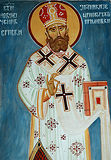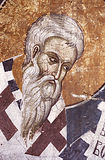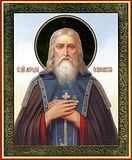

| Previous day | Next day |
| Old Style
June 4
|
Wednesday |
New Style
June 17
|
|
2nd Week after Pentecost.
Tone 8.
Fast of the Holy Apostles. |
Wine and oil allowed.
|
![]() St. Metrophanes, first archbishop of Constantinople (ca. 326).
St. Metrophanes, first archbishop of Constantinople (ca. 326). ![]() St. Methodius, founder of Peshnosha Monastery (Moscow), disciple of St. Sergius of Radonezh (1392).
St. Methodius, founder of Peshnosha Monastery (Moscow), disciple of St. Sergius of Radonezh (1392).
Martyrs Frontasius, Severinus, Severian, and Silanus, of Gaul (1st c.). Martyr Concordius of Spoleto, Italy (ca. 175). Hieromartyr Astius, bishop of Dyrrachium in Macedonia (110). St. Zosimas of Cilicia, bishop of Babylon in Egypt (6th c.). New Hieromartyr Ioannicius, metropolitan of Montenegro and the Littoral (1945). Sts. Eleazar and Nazarius, wonderworkers, of Olonets (15th c.).
Sts. Mary and Martha, sisters of St. Lazarus (1st c.). St. Titus, bishop of Byzantium (3rd c.). Hieromartyr Apotacius and Martyrs Zoticus, Atallus, Camasius, Philip, and 31 others, including Eutychius, Quirinus, Julia, Saturninus, Ninita, Fortunio, Gaddanus, and Amasus, beheaded at Noviodunum (Niculitel) (320). St. Optatus, bishop of Milevum in Numidia (376). St. Alonius of Scetis in Egypt (5th c.). St. Petroc, abbot, in Cornwall (594). Monk-martyr John, abbot, of Monagria Monastery, near Cyzicus (761). St. Sophia of Thrace (10th c.-11th c.).
Repose of Hieromonk Bartholomew of Neamts and Svir (1864) and the sisters Vera (June 4) and Lyubov (June 8) of the Shamordino Convent (1883).
Thoughts for Each Day of the Year
According to the Daily Church Readings from the Word of God
By St. Theophan the Recluse

Wednesday. [Rom. 4:13–25; Matt. 7:21–23]
Not everyone that saith unto me, Lord, Lord, shall enter into the kingdom of heaven; but he that doeth the will of my Father which is in heaven (Matt. 7:21). You will not be saved through prayer alone; you must unite with prayer fulfilment of the will of God—all that lies upon each person according to his calling and way of life. And prayer should have as its subject primarily the request that God enable us not to depart in any way from His holy will. Conversely, he who is zealous to fulfil God’s will in all things has boldness in prayer before God and greater access to His throne. Moreover, prayer that is not accompanied by walking in God’s will is often not true, sober and heartfelt prayer, but only external reading, during which one’s moral dysfunction is concealed by a multitude of words like a mist, while the thoughts are actually disorderly and wandering. Both must be made orderly through piety, and then there will be fruit.
Articles
 Martyrs Frontasius, Severinus, Severian, and Silanus, of GaulThe Holy Martyrs Frontasius, Severinus, Severianus, and Silanus suffered for Christ under the emperor Claudius (41-54). |
 Martyr Concordius of SpoletoThe Holy Martyr Concordius, son of the presbyter Gordian, was raised in piety and faith in Christ, and therefore Bishop Pius of Rome made him a subdeacon. |
 Sts. Mary and Martha, sisters of St. LazarusThe righteous sisters Martha and Mary were believers in Christ even before He raised their brother Saint Lazarus (October 17) from the dead. |
 Venerable Sophia of AinosOur venerable Mother Sophia was born in the province of Ainos in southeastern Thrace , and was the daughter of pious Christian parents. |









